Ancona Ducks
that Lay Green or Blue Eggs
Anconas lay white, green and blue eggs.
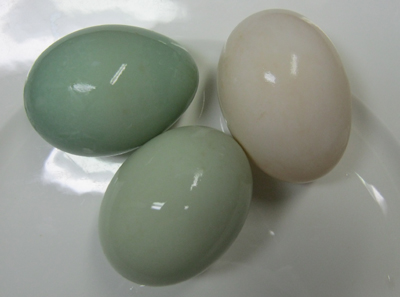
|
Female
Anconas Lay White, Green and Blue Eggs
Ancona eggs
are off-white (cream), light green, medium green, and bluish-green.
Each individual hen lays only 1 color of egg. She never changes egg color
throughout her laying years. The shape of the egg stays the same too for
each duck.
|
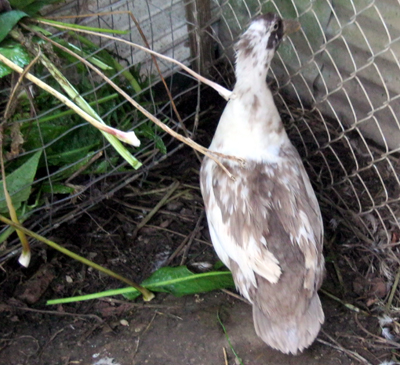
|
Hen that
Lays Green Egg
This female
Ancona lays a light green egg.
"An egg’s story begins in a female bird’s single ovary. When an ovum
is released into the oviduct and fertilized, it is just a protein-packed
yolk. The albumen—the gelatinous egg white—is added next. The blobby mass
then gets plumped up with water and encased in soft, stretchy membrane layers."
"The first globs of the calcium carbonate shell are then deposited on the
exterior, with the mineral squirting from special cells lining the shell
gland (uterus). Pigmentation, if any, comes next, with an overall protein
coating added before the egg is laid. It takes about 24 hours to build a
single egg."
-The Cornell University Lab, Ithaca, New York.
Article: 'The Beauty and Biology of Egg Color'
|
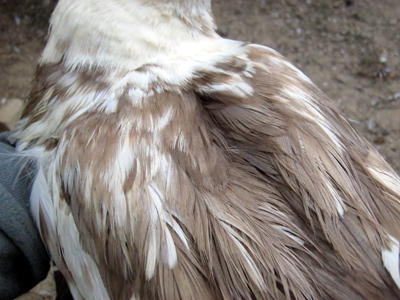
|
Closer
View of Above Hen
"Examination
of birds’ oviducts at the time the color is placed on the egg suggests that
the color is produced and released over a very short time frame, Birkhead
says, usually in the last few hours before the egg is laid."
-The Cornell University Lab, Ithaca, New York.
Article: 'The Beauty and Biology of Egg Color'
|
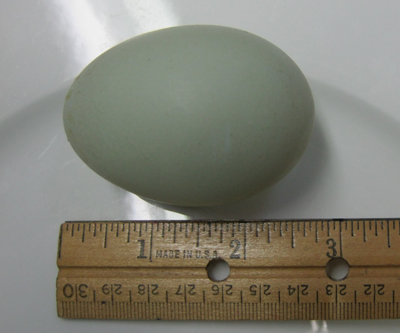
|
Egg Laid
by Above Hen
Ancona duck
eggs are bigger than chicken eggs. Their shells are harder and thicker.
"The colour is laid down in the thick, calcium-rich testa of the shell. The pattern tends to be in the cuticle, the outer protective layer. It is only in the later stages of the egg’s passage along the oviduct that the markings are applied by pigment-secreting areas of the uterus." -Indian Runner Duck Association, Hope
Welshpool Powys, England
|
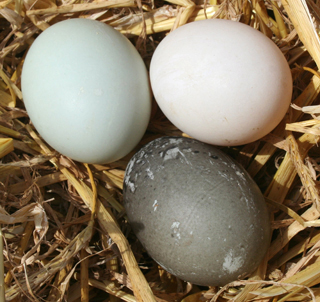
|
Gray
or Black on Egg
In late winter
and early spring after the hens have taken a rest from laying eggs, sometimes
the first few eggs come out with a gray or black tint.
After a few weeks
this color goes away (that is my experience). It is easy to clean off the black tint. Those eggs are still good for eating or hatching.
|
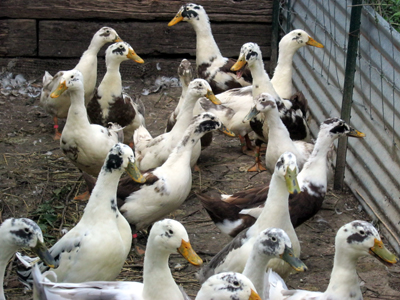
|
Group
of Ancona All from Green Eggs
The gene for
laying green eggs is not associated with just one feather color.
"Mazing (1933) found that the gene for white shell color was recessive but the abstract of his work does not specify whether it is sex-linked or autosomal (i.e. not sex-linked). In a recent communication (6 July 2010) Lancaster analysed Mazing’s results and concluded that the gene must be autosomal. He points out that egg shell colour is one of those awkward genetic characters which are difficult to investigate because of their biological limitations."
"1. It is a character of the female who lays the egg, not the embryo inside the egg.
2. It is sex limited, which means that it can only be expressed in the female parent. The male has no phenotype and has to be progeny-tested through his daughters.
3. The female’s phenotype cannot be determined until she is mature and starts laying."
-Indian Runner Duck Association, Hope
Welshpool Powys, England
|
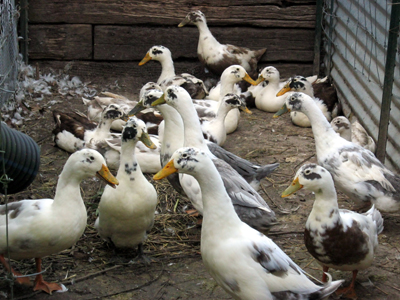
|
Same
Group of Ancona All from Green Eggs
"What is not possible, he asserts, is to get rid of green eggs by only hatching from white ones. ‘This is because the embryos could have been fathered by a green-egged male (GG or Gg). It only takes one very fertile “green” male to spread green eggs throughout the flock. Progeny-testing suspected males against known homozygous “white” females is the only way to remove male carriers of green eggs."
-Indian Runner Duck Association, Hope
Welshpool Powys, England
|

|
Ancona
Duck Eggs
The first
few eggs a young female duck lays are smaller. As she gets a little older,
the eggs get bigger until they reach the mature size. This is true for chickens
too.
"Evolution has played a massive role in terms of correlating pattern with habitat. Birds that lay in caves or holes tend to have plain whitish eggs. Those laying in the open have often evolved cryptic patterns: they camouflage the eggs against a background of pebbles, leaves or plants. The colours essentially are made up of two groups of pigment: porphyrin (reds and browns) and cyanin (blues and green). Ducks frequently hide their nests in vegetation, hence there is little need for elaborate protective markings." -Indian Runner Duck Association, Hope
Welshpool Powys, England
|
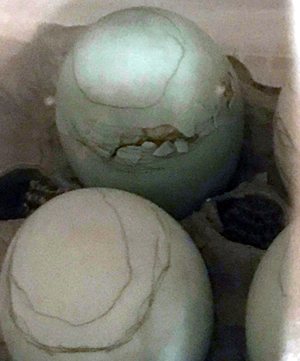
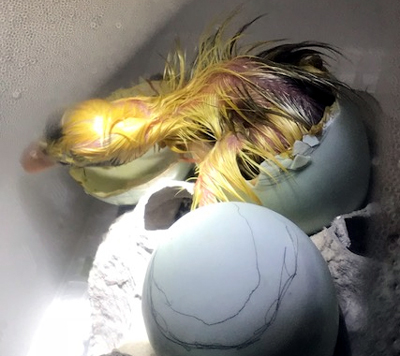
|
Blue-Green
Egg Unzipping
"I have charts and instructions everywhere around my eggs but I just couldn't resist looking. At this point already (day 5 of incubation), eight of the twelve eggs have definite red veins running through them. In four of them I was unable to tell (3 started developing later). I never expected to see anything this early but was so excited when I did! I am thrilled to see what I have so far."
"What an experience! Had our first beautiful little duckling hatch this morning and I got to watch! My dog woke us up at 4:30, and when I went to see what she was so interested in, I noticed one egg had unzipped after a worrisome 36 hours since the internal pip. As I was listening to him chirping, his little beak popped out and in less than 30 minutes he popped the top off of his egg and was out and about! His little peeps are priceless and so heart warming!"
"Even if this was my only little one to hatch - the experience was so worth it, and I am so in love with him! As of yesterday afternoon I had 3 or 4 more that had internal pips. I might have a surprise or two when I get home!"
-Michele, Maggie Valley, North Carolina
The photos are from Michele.
YouTube
Video, 1:23 minutes from Michele. Cute chirping Ancona duckling in shell in incubator.
|
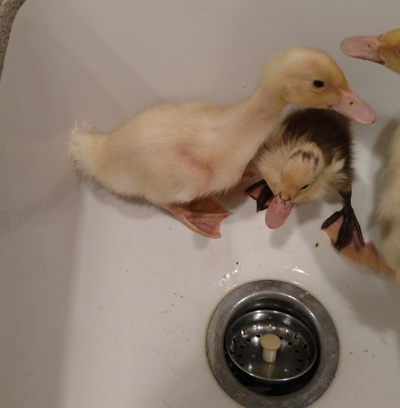
|
Duckling
from Blue-Green Egg
This photo is from Katherine in Urbanna, Virginia. The light-colored duckling is from one of my blue-green Ancona duck eggs.
The green-blue egg-laying gene is dominant. If your duck lays a white egg, her female children will lay white eggs unless the drake carries the gene for the green-blue egg.
If your duck lays a green-blue egg, then 50-100% of the female offspring
will lay green-blue eggs:
50% green-blue if the female carries the white egg trait, and the male only
has genes for white eggs.
75% green-blue if the male carries both the green-blue and white gene.
100% green-blue if the female and male don't carry the white-egg gene.
|
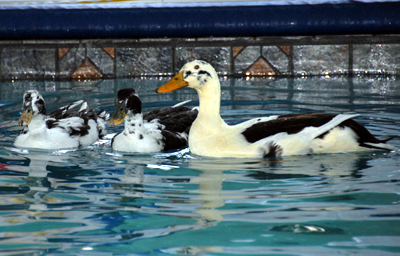
|
Happy
Ancona Ducks
"These are my Anconas. It has been so cold here (15 BELOW zero), I felt sorry for them. They are spending the next while inside until we figure out how to keep the barn warmer." -Jeanette, Park River, North Dakota in December
|
Buying
Ancona eggs
|










